Compliance tools play a crucial role in helping organizations navigate the complexities of regulatory requirements and standards. With features such as automated reporting, real-time monitoring, and robust data security, these tools not only streamline compliance management but also mitigate risks associated with non-compliance. As businesses in the UK evaluate their options, understanding the varying functionalities and benefits of different compliance tools is essential for effective decision-making.
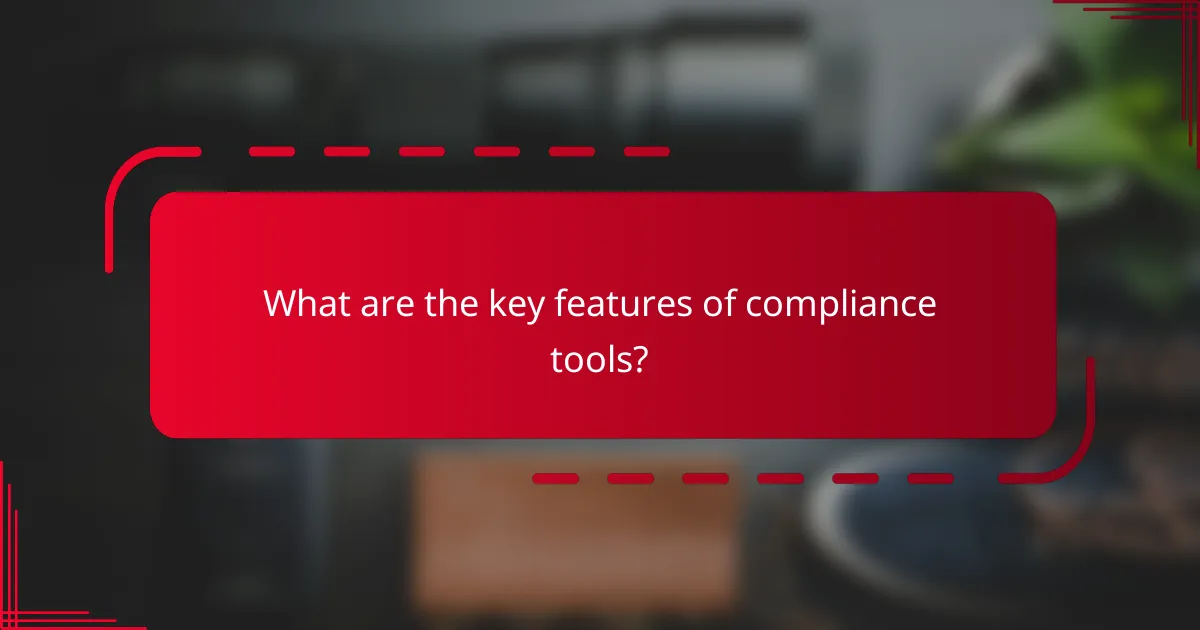
What are the key features of compliance tools?
Compliance tools are essential for organizations to ensure adherence to regulations and standards. Key features include automated reporting, real-time monitoring, data encryption, user access controls, and integration capabilities, which collectively enhance compliance management and risk mitigation.
Automated reporting
Automated reporting simplifies the process of generating compliance reports by pulling data from various sources and compiling it into a standardized format. This feature saves time and reduces human error, allowing organizations to produce reports quickly and accurately.
Many compliance tools offer customizable templates that align with specific regulatory requirements, making it easier to meet deadlines and avoid penalties. Regularly scheduled reports can help maintain ongoing compliance without manual intervention.
Real-time monitoring
Real-time monitoring enables organizations to track compliance status continuously, providing immediate insights into potential issues. This feature allows for proactive management of compliance risks and quick responses to any deviations from established standards.
By utilizing dashboards and alerts, compliance teams can stay informed about critical changes or violations as they occur, facilitating timely corrective actions. This capability is particularly valuable in industries with stringent regulatory requirements.
Data encryption
Data encryption is crucial for protecting sensitive information from unauthorized access, ensuring that compliance with data protection regulations is maintained. This feature encrypts data both at rest and in transit, safeguarding it against breaches.
Organizations should consider using compliance tools that offer strong encryption standards, such as AES-256, to meet requirements like GDPR or HIPAA. Regular audits of encryption practices can help identify vulnerabilities and enhance data security.
User access controls
User access controls manage who can view or edit compliance-related data, ensuring that only authorized personnel have access to sensitive information. This feature helps minimize the risk of data breaches and maintains accountability within the organization.
Implementing role-based access controls (RBAC) allows organizations to assign permissions based on job functions, which can streamline compliance processes. Regularly reviewing access permissions is essential to adapt to changes in personnel or roles.
Integration capabilities
Integration capabilities allow compliance tools to connect with other systems and software used within an organization, enhancing data flow and operational efficiency. This feature enables seamless sharing of information across platforms, reducing redundancy and improving accuracy.
When selecting a compliance tool, consider its ability to integrate with existing systems such as ERP, CRM, or document management software. Effective integration can lead to a more holistic view of compliance efforts and better decision-making.
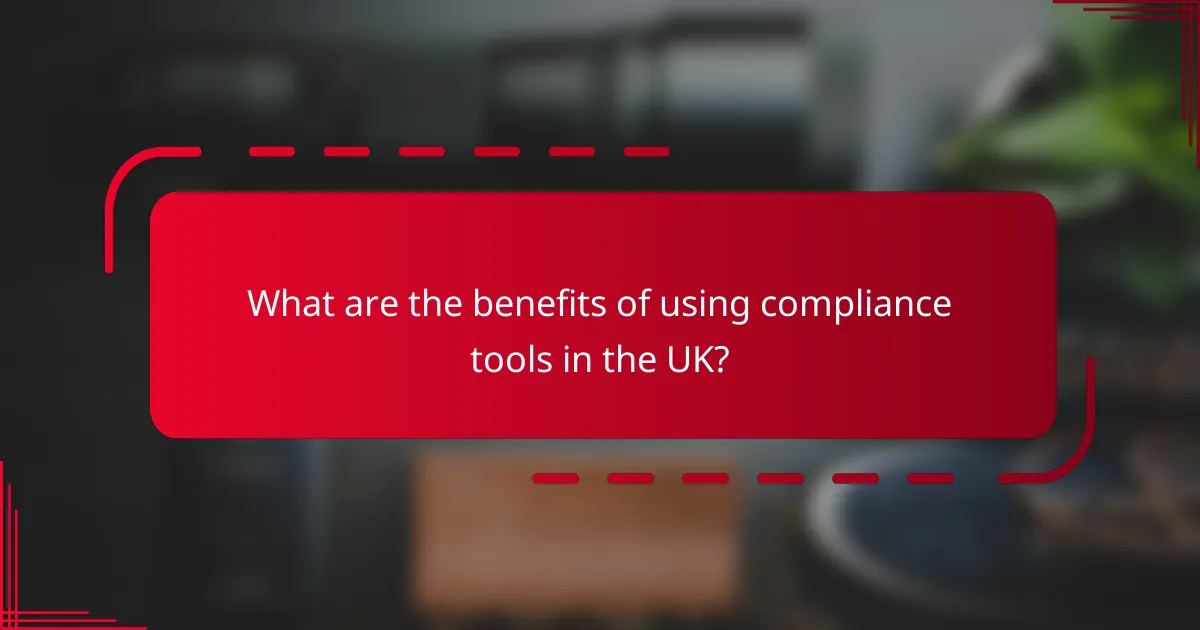
What are the benefits of using compliance tools in the UK?
Compliance tools in the UK offer significant advantages by helping organizations adhere to regulations, thereby minimizing risks and enhancing operational processes. These tools streamline compliance management, making it easier to meet legal requirements and protect sensitive information.
Reduced risk of penalties
Using compliance tools significantly lowers the risk of incurring penalties for non-compliance with UK regulations. These tools help organizations stay updated on changing laws and ensure that all necessary documentation is in place, reducing the likelihood of costly fines.
For example, automated alerts can notify businesses of upcoming deadlines for regulatory submissions, allowing them to take timely action. This proactive approach can save organizations from facing penalties that can range from hundreds to thousands of pounds.
Improved operational efficiency
Compliance tools enhance operational efficiency by automating routine compliance tasks, which frees up valuable time for employees. This automation reduces manual errors and allows staff to focus on more strategic activities that drive business growth.
For instance, tools that integrate with existing systems can streamline data collection and reporting processes, making it easier to maintain compliance without overwhelming staff. Organizations often find that they can reduce the time spent on compliance-related tasks by a significant percentage, leading to better resource allocation.
Enhanced data security
Implementing compliance tools improves data security by ensuring that sensitive information is handled according to established regulations. These tools often include features such as encryption, access controls, and audit trails, which help protect against data breaches.
In the UK, compliance with data protection regulations like the General Data Protection Regulation (GDPR) is crucial. Compliance tools can assist organizations in managing consent, data access requests, and breach notifications, thereby safeguarding customer data and maintaining trust.
Streamlined audits
Compliance tools facilitate streamlined audits by organizing and storing compliance documentation in a centralized location. This makes it easier for auditors to access necessary information quickly, reducing the time and effort required for audits.
Moreover, many compliance tools provide audit trails that track changes and actions taken within the system. This transparency can simplify the audit process, making it less stressful for organizations and ensuring they are well-prepared for any regulatory reviews.
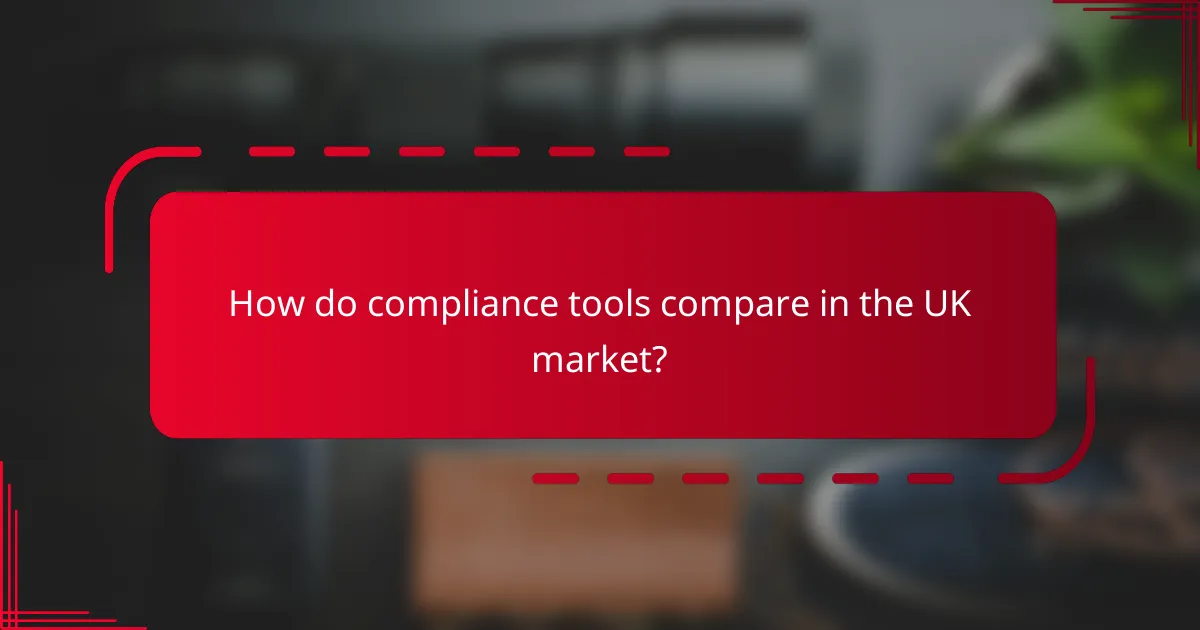
How do compliance tools compare in the UK market?
In the UK market, compliance tools vary significantly in features, usability, and pricing. Businesses must consider their specific regulatory needs and the functionalities offered by different tools to ensure effective compliance management.
Tool A vs Tool B
Tool A is known for its user-friendly interface and robust reporting capabilities, making it suitable for small to medium-sized enterprises. In contrast, Tool B offers advanced automation features that can streamline compliance processes but may require a steeper learning curve for users.
When choosing between Tool A and Tool B, consider the size of your organization and the complexity of your compliance requirements. For example, if your business frequently handles sensitive data, Tool B’s automation might save time and reduce errors.
Tool C vs Tool D
Tool C excels in integration with existing systems, allowing for seamless data transfer and compliance tracking. Tool D, however, focuses on real-time monitoring and alerts, which can be crucial for businesses needing immediate compliance updates.
Evaluate whether your priority is integration or real-time monitoring. If your organization relies on multiple platforms, Tool C may be the better choice, while Tool D could be advantageous for industries with stringent compliance deadlines.
Pricing comparisons
Pricing for compliance tools in the UK can range from low hundreds to several thousands of pounds annually, depending on features and user licenses. Tool A typically starts at a lower price point, appealing to startups, while Tool B’s advanced features justify a higher cost for larger firms.
When assessing pricing, consider not only the upfront costs but also potential long-term savings from improved compliance efficiency. Look for tools that offer tiered pricing models to accommodate growth and changing compliance needs.
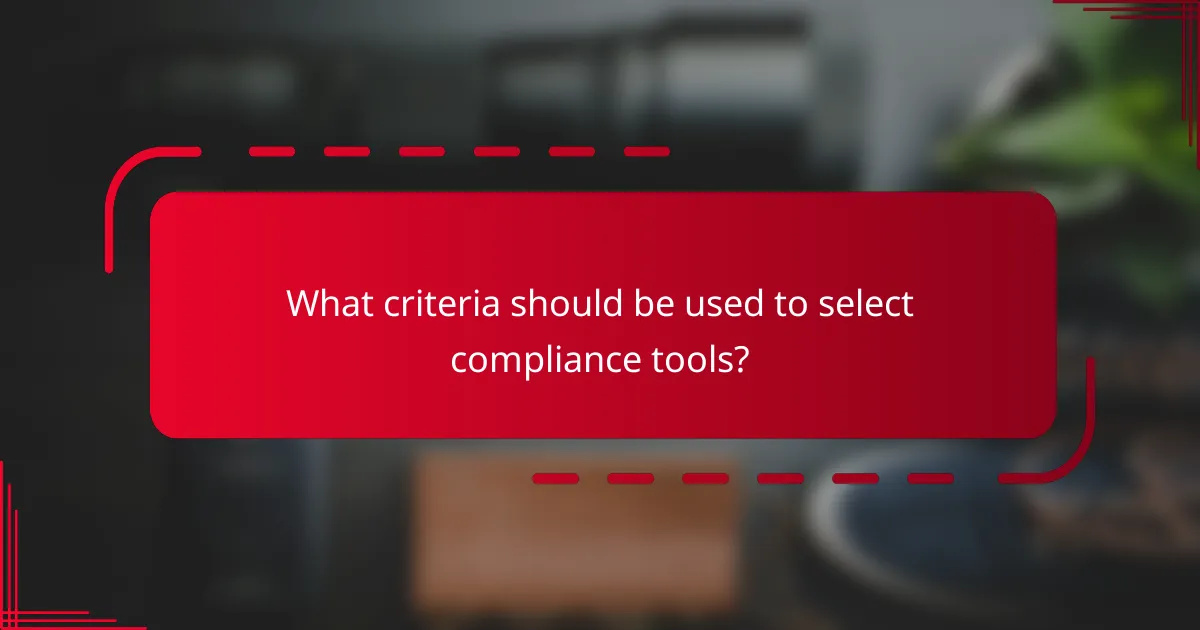
What criteria should be used to select compliance tools?
When selecting compliance tools, consider scalability, cost-effectiveness, and user-friendliness. These criteria ensure that the tool can grow with your organization, fit within your budget, and be easily adopted by your team.
Scalability
Scalability refers to a compliance tool’s ability to handle increasing amounts of work or data as your organization grows. Look for tools that can easily integrate additional features or accommodate more users without significant performance drops.
For example, a tool that offers tiered pricing plans or modular features allows you to expand your compliance capabilities as needed. This flexibility can save costs in the long run by avoiding the need for a complete system overhaul.
Cost-effectiveness
Cost-effectiveness evaluates whether a compliance tool provides good value relative to its price. Consider both upfront costs and ongoing expenses, such as subscription fees or maintenance charges.
It’s wise to compare tools based on features offered at various price points. A tool that appears cheaper may lack essential functionalities, leading to higher costs down the line due to inefficiencies or compliance failures.
User-friendliness
User-friendliness is crucial for ensuring that your team can effectively utilize the compliance tool. A tool with an intuitive interface and clear documentation can significantly reduce training time and improve adoption rates.
When evaluating user-friendliness, consider requesting demos or trials to gauge how easily your team can navigate the tool. A tool that requires extensive training may not be worth the investment if it complicates compliance processes instead of simplifying them.
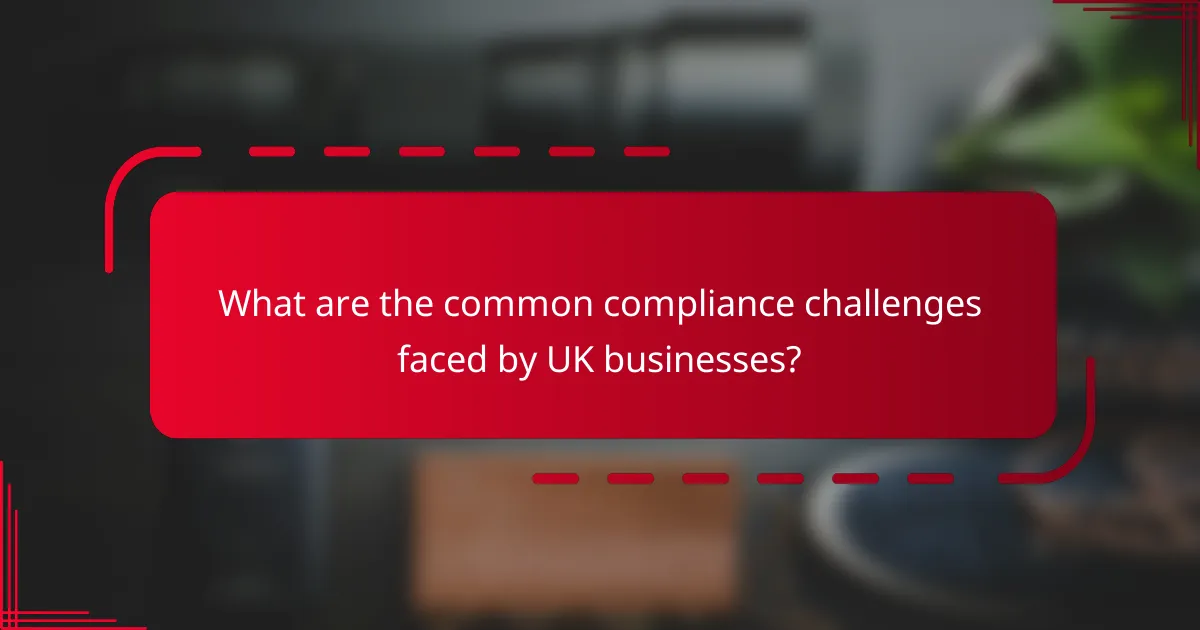
What are the common compliance challenges faced by UK businesses?
UK businesses often encounter challenges related to data protection, industry-specific standards, and evolving regulations. These issues can lead to significant risks, including financial penalties and reputational damage if not properly managed.
Data protection regulations
Data protection regulations, particularly the UK General Data Protection Regulation (GDPR), pose significant challenges for businesses. Compliance requires organizations to implement strict data handling practices, including obtaining consent, ensuring data security, and allowing individuals to exercise their rights over their personal information.
To navigate these regulations effectively, businesses should conduct regular audits of their data processing activities and maintain clear documentation. Common pitfalls include failing to update privacy policies or neglecting to train staff on data protection practices.
Industry-specific standards
Many industries in the UK are governed by specific compliance standards, such as the Financial Conduct Authority (FCA) regulations for financial services or the Health and Safety Executive (HSE) guidelines for workplace safety. Adhering to these standards is crucial for maintaining operational integrity and avoiding legal repercussions.
Businesses should familiarize themselves with the relevant standards for their sector and implement necessary protocols. Regular training and updates on compliance requirements can help mitigate risks associated with non-compliance, ensuring that employees understand their responsibilities and the importance of adherence.

How can compliance tools help with GDPR compliance?
Compliance tools are essential for organizations seeking to meet GDPR requirements effectively. They streamline processes, automate data management, and ensure that personal data handling aligns with legal standards.
Key features of compliance tools for GDPR
Compliance tools designed for GDPR typically include features such as data mapping, consent management, and automated reporting. Data mapping helps organizations understand where personal data resides, while consent management ensures that user permissions are properly documented and maintained.
Automated reporting features allow businesses to generate compliance reports quickly, which can be crucial during audits. Additionally, many tools offer risk assessment capabilities to identify potential vulnerabilities in data handling practices.
Benefits of using compliance tools for GDPR
Utilizing compliance tools for GDPR can significantly reduce the workload associated with manual compliance efforts. These tools enhance accuracy in data processing and help avoid costly fines by ensuring adherence to regulations.
Moreover, they improve transparency and accountability in data management, fostering trust with customers. By providing clear insights into data usage and consent, organizations can better align their practices with GDPR principles.
Comparing compliance tools for GDPR
When comparing compliance tools for GDPR, consider factors such as ease of use, integration capabilities, and support services. Some tools may offer more comprehensive features, while others might focus on specific aspects like consent management or data protection impact assessments.
Pricing can vary widely, with some tools available for a monthly subscription and others requiring a one-time purchase. It’s essential to evaluate the total cost of ownership, including potential costs for training and ongoing support.
